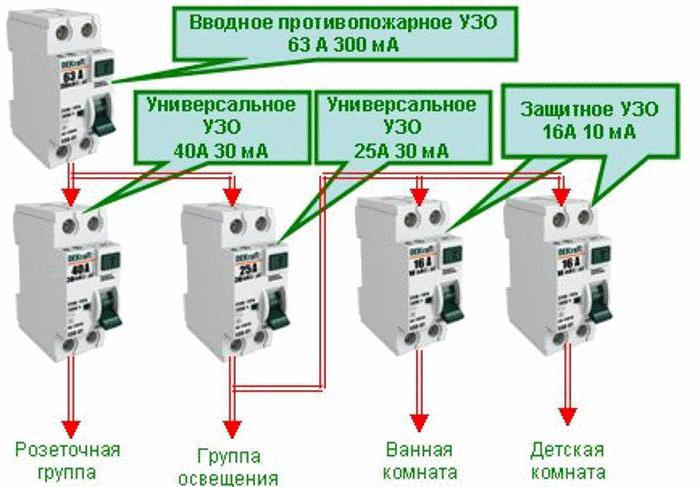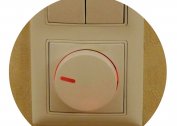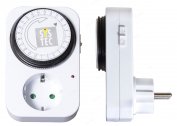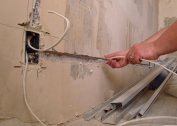RCD - residual current device. It is a special device that, during insulation breakdowns, relieves voltage in the circuit into which it is connected in order to prevent current leakage. To connect an RCD without grounding in the apartment, you need to understand the principles of the system.
What is the need to install an RCD?
RCD is a necessary measure to protect living things from the negative effects of electric current. The device also prevents the ignition of electrical wiring in case of its mechanical malfunctions.
The electrical circuit may be damaged for several reasons:
- under the influence of high temperatures;
- due to physical deterioration of the insulation;
- with external mechanical interference and violation of the integrity of the circuit.
If there is no RCD connection, contact of a person with damaged electrical wiring can lead to serious consequences, even death. Also, in the absence of the owner in the room, a fire can start. Of particular danger are wooden structures that are flammable.
How RCDs work with and without grounding
Without grounding, if the insulation is damaged on the instrument case, a dangerous potential arises. The risk is that the protective mechanism of the controller will not work, since there is no current output in the circuit.
Upon contact with a person or other living creature (for example, a pet), a current leak will pass through his body towards the ground - he will find grounding. The current will flow through the human body until its value corresponds to the threshold value at which the protective device is activated. Only after that the circuit will turn off and the power will cease to flow. The duration of the negative impact depends on the magnitude at which the control mechanism is triggered.
In general cases, the process lasts no more than a minute, however, a couple of seconds may be enough for a person to receive serious injuries.
If the RCD is connected with ground, the circuit is turned off immediately when a positive difference occurs between the input and output. Therefore, a dangerous potential does not arise on the instrument case, and the excess current goes into the ground, without exerting any effect on the person.
Operating principle
 Since RCD is a device for protecting a person from electric shock, the principle of action is based on the neutralization of the dangerous potential of the equipment case. To the upper terminals of the device, phase and zero are connected directly from the energy generator, and to the lower terminals are phase and zero from the load. Thus, the circuit of the current flow along the circuit is in order from the electricity source through the RCD on the wire to the appliance, and then returns in the reverse order to the network.
Since RCD is a device for protecting a person from electric shock, the principle of action is based on the neutralization of the dangerous potential of the equipment case. To the upper terminals of the device, phase and zero are connected directly from the energy generator, and to the lower terminals are phase and zero from the load. Thus, the circuit of the current flow along the circuit is in order from the electricity source through the RCD on the wire to the appliance, and then returns in the reverse order to the network.
In the circuit, the device acts as the main controller of the current strength, which enters and leaves it, respectively. If the difference is non-zero, a leak is detected, the signal of which enters the RCD and in less than a second the electrical circuit is turned off.
In a stable and serviceable network, there is no noticeable difference between the incoming and outgoing voltage, so the controller does not work and all connected equipment is working properly. In emergency situations with current leakage, the entire electrical network stops working, preventing ignition or direct contact with people.The principle of operation is primarily aimed at safety, therefore, the RCD does not react in any way to emergency situations that are not accompanied by current leaks, for example, overload of the power supply network or short circuit in it.
How to connect an RCD if there is no ground
The practical implementation of the method that excludes grounding occurs according to the following algorithm:
- The power goes out.
- The RCD is fixed on the din rail using special latches.
- The input terminal is connected first, then the neutral wire. The corresponding designations can be found on the enclosures of the device.
- All machines are distributed phase output.
- The output of pin N is connected to the neutral bus.
- The introductory machine is turned on, and the circuit is checked for correct connections.
When you click on the test button, the RCD should turn off. If there is a problem with the device itself or if the connections are connected incorrectly, this does not happen.
Circuit options
Before connecting an RCD without grounding, make sure that the standard automatic devices are present in the circuit. It is connected in two ways:
- at the entrance;
- to the entrance and to the branch branches.
It is important that the device is connected only in combination with a circuit breaker, otherwise it will not perform its function.
Input connection
This option involves the inclusion of the device in the overall circuit to protect all home wiring. For this method, it is necessary to connect the RCD and the machines of the outgoing connections.
Significant savings can be distinguished from the advantages of the input connection scheme, since only one controller is used to ensure security. However, at the same time, there are drawbacks. For example, when a phase is closed on one device, the entire power supply system fails and the voltage supply to all connected equipment in the apartment stops.
Before choosing this option, it is advisable to weigh the pros and cons of this method of operating the device. The circuit is suitable for connecting an RCD in a single-phase system without grounding.
Connection at the inlet and outgoing branches
To implement this scheme, several RCDs in a two-wire network will be needed. As in the previous version, one of them is installed at the entrance after the input automatic machine, and the rest are placed immediately after the automatic switches of the outgoing connections.
The number of devices needed depends on the grouping and home network layout. Most often they use separation into lighting and outlet sources. Sometimes a method is used to separately protect expensive and energy-consuming equipment that consumes electricity. In this case, the installation of an RCD in a two-wire network without grounding is ideal.
Mistakes to Avoid
Often, with the self-installation of an RCD in a house without grounding, errors are made:
- neutral and grounding are included in the circuit after the protection device;
- the connection is out of phase;
- ground and ground conductors are connected;
- two RCDs are connected by combining zeros;
- polarity is not respected.
To avoid mistakes, it is advisable to involve professional electricians in the installation. Also, after connecting, it is necessary to conduct a test run by pressing the corresponding button on the device.





